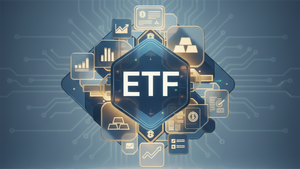
Ethereum (ETH), the foundational blockchain for countless decentralized applications, is poised for a significant surge, with recent analyses projecting its value to reach an impressive $9,801 by 2030. This optimistic forecast is not mere speculation but is firmly anchored in several transformative trends shaping the cryptocurrency landscape: the escalating adoption of Layer-2 (L2) scaling solutions, the burgeoning influx of new institutional staking products, and the sustained, vigorous expansion of decentralized finance (DeFi) and non-fungible token (NFT) activities.
This potential ascent of Ethereum carries profound implications for the entire crypto market, signaling a maturing ecosystem and potentially redirecting capital flows. Investors and market participants are now closely watching how these intertwined developments will reshape the future of digital finance and the broader Web3 economy, cementing Ethereum's role as a cornerstone of decentralized innovation.
The Triple Engines of Growth: Layer-2s, Institutional Staking, and DeFi/NFT Boom
The anticipated climb of Ethereum to nearly $10,000 is underpinned by a confluence of technological advancements and market dynamics. Each driver plays a critical role in enhancing Ethereum's utility, accessibility, and appeal to a widening demographic of users and institutions.
Layer-2 networks are at the forefront of this transformation. As Ethereum's mainnet grapples with scalability challenges, L2 solutions like Arbitrum (ARBITRUM) and Optimism (OP) have emerged as vital conduits, offloading transaction processing from the main blockchain while maintaining its security. By reducing gas fees and speeding up transaction times, L2s are making the Ethereum ecosystem more user-friendly and economically viable for a broader range of applications and users. Industry experts, including VanEck, foresee a colossal $1 trillion collective market capitalization for Ethereum's Layer-2 protocols by 2030, a testament to their pivotal role in scaling the network and driving its adoption. This expansion is critical, ensuring that Ethereum can handle the increasing demand stemming from DeFi, NFTs, and other decentralized applications without succumbing to network congestion or prohibitive costs.
Simultaneously, the crypto world is witnessing an unprecedented influx of institutional interest, particularly in Ethereum's Proof-of-Stake (PoS) staking mechanism. The introduction of institutional-grade staking products and the anticipated launch of spot Ethereum Exchange-Traded Funds (ETFs) are monumental catalysts. These regulated investment vehicles provide traditional financial institutions and their clients with a secure and compliant pathway to gain exposure to ETH, which was previously a barrier for many. Analysts suggest that these ETFs will not only attract substantial capital but also effectively remove a significant amount of ETH from circulation as it gets staked, contributing to a potential supply squeeze. This institutional embrace, evidenced by major firms accumulating ETH at a pace exceeding retail demand, indicates a structural shift that could exert sustained upward pressure on Ethereum's price. Companies like Coinbase (COIN) and Fidelity (FNF) are among those expected to play a key role in facilitating this institutional adoption through their various staking and custodial services.
Finally, the relentless expansion of decentralized finance (DeFi) and non-fungible token (NFT) activity continues to cement Ethereum's dominance. Ethereum remains the undisputed king of the DeFi landscape, commanding the largest Total Value Locked (TVL) by a significant margin compared to other blockchains. This dominance means that the vast majority of innovative financial applications, from lending protocols to decentralized exchanges, operate on or are closely integrated with Ethereum. The thriving NFT market, too, predominantly relies on Ethereum, with iconic marketplaces like OpenSea and prominent collections choosing it as its primary blockchain. As Web3 applications, tokenized real-world assets, decentralized governance, and NFTs become more mainstream, the demand for ETH as gas for transactions and collateral within these ecosystems is projected to skyrocket. This sustained activity and Ethereum's status as the default smart contract platform make it a central pillar of the decentralized web, driving its long-term value.
Shifting Fortunes: Who Wins and Who Faces Challenges in Ethereum's Ascent
Ethereum's projected growth, driven by its technological evolution and expanding utility, is set to create distinct winners and losers across the cryptocurrency landscape and traditional finance. Adaptability, innovation, and strategic positioning will be crucial for navigating this evolving market.
The most immediate beneficiaries of Layer-2 adoption are the Layer-2 protocols themselves and the decentralized applications (dApps) built upon them. Protocols like Arbitrum (ARBITRUM), Optimism (OP), Polygon (MATIC), zkSync, StarkNet, and Coinbase's (COIN) Base are experiencing burgeoning activity as users and developers flock to their high-throughput, low-cost environments. These L2s enable dApps, from decentralized exchanges like Uniswap (UNI) to lending platforms like Aave (AAVE), to offer a significantly enhanced user experience, fostering greater liquidity and broader participation. Their native tokens could see increased demand as they become integral to gas payments and governance within these thriving ecosystems. Individual Ethereum users also emerge as significant winners, benefiting directly from reduced transaction fees and faster settlement times, making micro-transactions and frequent DeFi interactions economically viable. However, the Ethereum mainnet (Layer-1) itself might see a reduction in direct transaction revenue as activities shift off-chain, potentially impacting its burning rate and, under certain conditions, leading to an inflationary supply model, a concern highlighted by the Dencun upgrade and EIP-4844. Furthermore, while the overall L2 market is growing, not all L2 projects will thrive equally, as evidenced by some new entrants' token prices plummeting post-airdrops, suggesting that strong fundamentals are vital beyond initial hype.
In the realm of institutional staking, liquid staking protocols such as Lido (LDO) and Rocket Pool (RPL) are poised for substantial gains. These protocols allow users to stake ETH while retaining liquidity through derivative tokens like stETH or rETH, which can then be deployed in other DeFi activities, creating compounding yields. Newer entrants like EigenLayer, with its restaking mechanism, are opening up entirely new markets for shared security and additional yield generation. Institutional investors (e.g., asset managers like BlackRock (BLK) and Fidelity (FNF)) and companies providing institutional staking solutions (e.g., Fireblocks, ConsenSys, Kiln, Coinbase (COIN), Kraken (KRAK)) are also major winners. The approval of spot Ethereum ETFs provides a regulated on-ramp for traditional finance to access ETH staking rewards, offering stable income streams, diversification, and potentially aligning with ESG initiatives due to Ethereum's post-Merge energy efficiency. These infrastructure providers offer the enterprise-grade, compliant, and secure services essential for institutional participation. Ultimately, all ETH holders stand to benefit from the reduced circulating supply caused by increased staking, leading to upward price pressure and attractive staking yields.
The expansion of DeFi and NFT activity presents a mixed bag. Established DeFi protocols like Uniswap (UNI), Aave (AAVE), Compound (COMP), and MakerDAO (MKR) will continue to benefit from increased liquidity and user adoption, especially as L2s make these services more accessible. The burgeoning trend of Real-World Asset (RWA) tokenization, facilitated by platforms like Centrifuge (CFG) and Chainlink (LINK), is attracting significant institutional capital, creating new investment opportunities and enhancing market efficiency. Custodial infrastructure providers (e.g., Coinbase Custody, BitGo, Anchorage Digital) are also in a strong position as regulatory clarity mandates qualified custody for institutional DeFi engagement. Conversely, traditional financial institutions (banks, brokers) that fail to embrace or integrate with DeFi alternatives risk losing market share due to DeFi's lower costs, greater transparency, and higher potential yields. In the NFT space, marketplaces like OpenSea and Blur (BLUR), alongside individual creators and artists, are significant winners. NFTs democratize the creative economy, empowering artists to connect directly with global audiences, bypassing traditional intermediaries and earning royalties on secondary sales. Projects building NFTs on specialized Layer-2s like ImmutableX (IMX) are solving scalability issues for digital collectibles, making creation and trading more efficient. However, speculative investors and overhyped NFT projects lacking utility or long-term vision face significant risks, as the market has demonstrated considerable volatility and correction. Traditional art galleries and intermediaries that do not adapt to digital art and blockchain technologies may also see their influence wane.
Broader Horizons: Industry Impact and Systemic Implications
Ethereum's robust growth trajectory, fueled by scaling solutions, institutional integration, and ecosystem expansion, signifies far more than just a rising asset price; it marks a pivotal moment in the evolution of digital finance and the broader technological landscape. These drivers are not isolated phenomena but are deeply embedded within overarching industry trends, setting off ripple effects across competitors, partners, and regulatory bodies, drawing historical parallels to past technological and financial revolutions.
The advancements in Layer-2 scaling solutions directly address the Achilles' heel of early blockchain adoption: scalability. By making transactions faster and cheaper, L2s like Arbitrum (ARBITRUM) and Optimism (OP) are transforming Ethereum from a niche technological marvel into a genuinely viable global settlement layer for a multitude of applications. This aligns perfectly with the broader trend of accelerated blockchain adoption across industries beyond just cryptocurrency, including finance, healthcare, and supply chain management. Ethereum, with its enhanced efficiency, stands to become an even more attractive foundation for enterprises seeking to leverage blockchain's benefits for faster settlements, transparency, and tamper-resistant record-keeping. This also puts pressure on competing Layer-1 blockchains, such as Solana (SOL), Cardano (ADA), and Polkadot (DOT), to innovate their own scaling and ecosystem development, or risk ceding further market share to Ethereum's burgeoning network effect.
The surge in institutional staking and the advent of spot Ethereum ETFs represent a profound shift towards mainstream DeFi traction and asset tokenization. Traditionally, institutions have been wary of the unregulated and volatile crypto markets. However, with clearer regulatory frameworks and secure, compliant products, Ethereum is transitioning from a speculative asset to a productive, yield-generating financial instrument. This trend is further amplified by the rapid growth of Real-World Asset (RWA) tokenization, where physical assets like real estate, bonds, and commodities are represented as digital tokens on the blockchain. Ethereum currently accounts for over 80% of RWA tokenization, with major players like Singapore's DBS Bank tokenizing structured notes on the network. This signifies Ethereum's evolution into a global settlement layer for institutional capital, challenging the traditional financial intermediaries and driving a broader integration of digital assets into the legacy financial system. Firms like Chainlink (LINK), which provide crucial data connectivity for RWA tokenization, and custodians like Coinbase Custody (COIN), are poised to be key partners in this institutional embrace.
From a regulatory and policy perspective, Ethereum's increasing prominence brings both increased scrutiny and greater legitimacy. As its market capitalization grows and institutional involvement deepens, regulators globally, including the U.S. SEC, will inevitably intensify their oversight. Concerns regarding centralization in staking, particularly with proposals like EIP-7251 consolidating staking power, could invite stricter regulations. There remains an ongoing risk of Ethereum being classified as a security, which would have significant operational implications. However, the approval of Ethereum ETFs signals a growing regulatory acceptance, boosting market confidence and attracting substantial capital inflows. Policies like the GENIUS Act supporting stablecoins, a market heavily dominated by Ethereum, further legitimize the ecosystem. Regulators are increasingly seeking a balance between fostering innovation, ensuring consumer protection, and preventing illicit activities, pushing for more standardized and transparent frameworks that, in turn, reduce perceived risks for institutional investors.
Historically, this trajectory draws parallels to the evolution of transformative technologies like the internet itself. Just as the early internet revolutionized information exchange and enabled entirely new industries, blockchain technology, with Ethereum at its forefront, is redefining value exchange and enabling decentralized applications that challenge established paradigms. The initial speculative fervor around various cryptocurrencies can be compared to the "dot-com bubble," where immense innovation occurred alongside speculative excess. However, the sustained development of core infrastructure like Layer-2s and the integration with institutional finance suggest a more mature phase of adoption, akin to how the internet eventually moved beyond dial-up and embraced e-commerce and cloud computing. This ongoing redefinition of what constitutes currency and financial infrastructure is a continuous historical process, with blockchain emerging as a fundamental building block for the digital economy of the future.
The Road Ahead: Navigating Ethereum's Evolving Landscape
Ethereum's projected ascent to $9,801 by 2030 is not merely a forecast but a roadmap for its continued evolution, marked by a series of technological upgrades and strategic adaptations that will shape its short-term trajectory and long-term destiny. Stakeholders across the ecosystem—from developers to institutional investors—will need to pivot and adapt to capitalize on the emerging opportunities and mitigate the inherent challenges.
In the short-term (late 2024 - 2025), Ethereum's focus remains squarely on enhancing scalability, security, and user experience. The "Surge" phase of its roadmap, spearheaded by Layer-2 (L2) solutions and facilitated by upgrades like the Dencun upgrade (March 2024), has already drastically reduced L2 transaction costs through proto-danksharding (EIP-4844), making dApps more accessible. The upcoming Pectra upgrade (expected May 2025), a combination of Prague and Electra, is a critical milestone, set to refine staking mechanics, increase the staking limit to 2,048 ETH, and introduce Account Abstraction (EIP-7702). This latter feature is particularly transformative, promising to make smart contract wallets more user-friendly with capabilities like transaction batching and sponsored fees, significantly lowering the barrier to entry for mainstream users. The anticipated approval of spot Ethereum ETFs in the U.S. will also be a major short-term catalyst, likely unleashing a wave of institutional capital, mirroring the impact seen with Bitcoin ETFs.
Looking towards the long-term (2025 - 2030 and beyond), Ethereum envisions becoming a "global computer" and a foundational layer for the world economy. This involves achieving full sharding, which could eventually boost transaction throughput to over 100,000 transactions per second (TPS), far beyond current capabilities. Ethereum is positioned to continue leading the expansion of DeFi, NFTs, and the broader Web3 economy, powering everything from decentralized social graphs and identity systems to AI and robotics infrastructure. A significant long-term opportunity lies in Real-World Asset (RWA) tokenization, where Ethereum is expected to serve as the primary rails for fractional ownership and increased liquidity of traditional assets like real estate, stocks, and bonds. This will attract enterprise adoption from financial giants and tech companies integrating blockchain into their core operations.
Strategic pivots and adaptations are imperative for all stakeholders. Developers and dApp builders must increasingly leverage L2 solutions and focus on interoperability to avoid fragmentation. They also need to embrace new features like Account Abstraction to enhance user experience. Institutional investors will need to adapt to new investment vehicles like spot ETH ETFs and explore native staking opportunities, considering Ethereum for strategic treasury allocations. The Ethereum Foundation and core developers are strategically reorganizing leadership and prioritizing Layer 1 scaling, blob efficiency, and UX improvements while actively mitigating centralization concerns related to Maximum Extractable Value (MEV) and liquid staking. Businesses and enterprises will need to build expertise in blockchain technology and regulatory compliance to integrate Ethereum-based solutions for payments and asset tokenization.
The market presents both significant opportunities and formidable challenges. Opportunities include mass adoption driven by scalable L2s, substantial institutional inflows through ETFs and RWA tokenization, and the continued robust growth of DeFi and NFTs. Ethereum's potential to become a deflationary asset through its Proof-of-Stake model and EIP-1559 further bolsters its appeal as a store of value. However, challenges loom large, including fierce competition from rival Layer-1 blockchains (e.g., Solana (SOL), Cardano (ADA)), potential fragmentation across L2s, and persistent, albeit mitigated, high gas fees on the mainnet during peak congestion. Regulatory scrutiny remains a perennial concern, with unfavorable policies capable of stifling growth. While quantum computing poses a distant threat, the immediate challenge lies in market sentiment and volatility, which can create a disconnect between robust infrastructure development and short-term investor performance.
Ultimately, while the $9,801 projection aligns with a moderately bullish outlook, many experts foresee significantly higher values (e.g., $22,000 to $154,000 by 2030 in optimistic scenarios). The success of Layer-2s in handling the vast majority of transactions, the sustained influx of institutional capital through staking and ETFs, and the continuous innovation in DeFi and NFTs are critical drivers. Ethereum's network effects, with its massive dApp ecosystem and Total Value Locked (TVL), create a gravitational pull for new projects and users. The actual price outcome will hinge on how effectively Ethereum navigates competition, regulatory complexities, and its ambitious development roadmap to truly become the foundational layer of the decentralized global economy.
The Unfolding Future: A Concluding Assessment of Ethereum's Trajectory
Ethereum's projected journey to an average price of $9,801 by 2030, while an impressive figure, represents just one facet of a broader and more ambitious vision for the world's leading smart contract platform. This forecast is a testament to the compounding effects of its ongoing technological evolution, its vibrant and expanding ecosystem, and the accelerating integration with traditional finance. Far more than just a cryptocurrency, Ethereum is solidifying its role as the foundational digital infrastructure for the decentralized web, poised to leave a lasting impact on how value is exchanged, owned, and governed.
The key takeaways from this analysis are clear: Ethereum's future growth is intrinsically tied to the success of its Layer-2 scaling solutions, which are making the network truly accessible and efficient for a global user base. The dramatic reduction in transaction costs and increased throughput enabled by proto-danksharding and future upgrades are pivotal. Simultaneously, the burgeoning institutional interest, particularly through new staking products and the anticipated spot Ethereum ETFs, is set to inject substantial capital and legitimacy into the ecosystem, transforming ETH into a productive, yield-generating asset within traditional portfolios. Lastly, the relentless innovation and expansion within DeFi and NFTs continue to drive fundamental demand for ETH, cementing its utility as the "gas" for a rapidly evolving digital economy, from tokenized real-world assets to decentralized autonomous organizations.
Assessing the market moving forward, the outlook for Ethereum remains predominantly bullish. Analysts largely agree that its robust technology, unparalleled security, and formidable network effects position it for sustained growth. However, investors must remain cognizant of the inherent volatility in the crypto market, which can be influenced by broader macroeconomic conditions and ongoing regulatory developments. Competition from other Layer-1 blockchains, while intense, also fosters innovation across the entire industry. While Layer-2s are crucial for scalability, the discussion around how value is captured between the mainnet and these scaling solutions will be an evolving dynamic to watch.
In final thoughts on its significance and lasting impact, Ethereum is not merely a digital currency but a transformative technology akin to the early internet, empowering a paradigm shift in financial services, digital ownership, and online interaction. Its open, programmable nature is fostering an ecosystem of innovation that extends beyond finance, into areas like AI, gaming, and decentralized identity. The transition to Proof-of-Stake has also positioned Ethereum as a more environmentally sustainable blockchain, aligning with broader global ESG trends and making it more appealing to a wider range of institutional investors. Ethereum's adaptability and utility will ensure its place as a cornerstone of the digital economy for decades to come.
For investors in the coming months, vigilance will be key. Pay close attention to the successful implementation and impact of upcoming network upgrades like Pectra and subsequent phases, as these technical milestones are crucial drivers of efficiency and adoption. Monitor the flow of institutional capital into Ethereum, particularly following any ETF approvals, as this will provide significant market validation and buying pressure. Observe the growth and activity within the Layer-2 ecosystem, understanding how users and value are migrating and being captured. Finally, stay informed on the broader macroeconomic and regulatory landscape, as these external factors can profoundly influence market sentiment and price action. While short-term fluctuations are inevitable, the strong fundamental developments and expanding utility continue to build a compelling long-term case for Ethereum.







